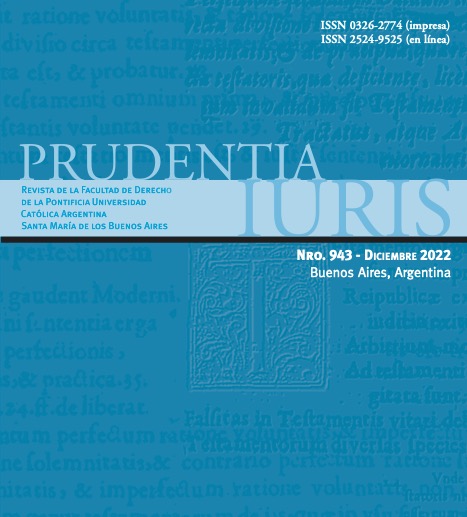ACERCA DE LA PROTECCIÓN CONSTITUCIONAL DE LOS NEURODERECHOS: LA INNOVACIÓN CHILENA
DOI:
https://doi.org/10.46553/prudentia.94.2022.pp.39-68Palabras clave:
Neuroderechos, Neurotecnología, Neurociencias, Privacidad mentalResumen
Después de un proceso legislativo de más de dos años, se ha promulgado en la República de Chile la Ley N° 21.383 (14 de octubre de 2021), que modifica la Carta Fundamental con el objeto de incorporar la protección de las personas frente al desarrollo científico y tecnológico, concretamente en su dimensión “cerebral”. Esta reforma constitucional es reflejo de la preocupación por la forma en que el avance neurotecnológico podría impactar en la sociedad, cuestión que ha impulsado el surgimiento de una doctrina orientada a proteger los bienes jurídicos que se verían amenazados en este contexto, expresándose en el concepto de “neuroderechos”. El presente trabajo reflexiona sobre las bases conceptuales y jurídicas del mensaje contenido en el proyecto que da origen a esta primera reforma constitucional a nivel mundial para proteger los “neuroderechos”, así como sobre el texto mismo de la norma recientemente promulgada.
Descargas
Referencias
Alivisatos, P. A.; Chun, M.; Greenspan R. J.; Roukes, M. L. y Yuste, R. (2012). “The brain activity map project and the challenge of functional connectomics”. En Neuron. 21(74), 2012, 970-974. DOI: 10.1016/j.neuron.2012.06.006. PMID: 22726828; PMCID: PMC3597383.
Alivisatos, P. A.; Chun, M.; Church, G. M.; Deisseroth, K.; Greenspan, R. J.; Batson, C. D. (2009). “These things called empathy: Eight related but distinct phenomena”. En The social neuroscience of empathy. Cambridge. MIT Press, 3-16.
Bedzow, I. (2018). “The confused ethics of cognitive enhancers”. En J Clin Psychiatry Neurosci. 1, 12-14.
Blank, R. (2016). Cognitive Enhancement. Social and Public Policy Issues. Hampshire. Palgrave/Pivot.
Bostrom, N. (2009). “Why I want to be Posthuman”. En Medical Enhancement and Posthumanity. Amsterdam. Springer, 107-137.
Bostrom, N. y Roach, R. (2007). “Ethical issues in human enhancement”. En New Waves in Applied Ethics. Basingstoke. Palgrave Macmillan, 120-152.
Braidotti, R. (2013). The Posthuman. Cambridge Polity Press.
Buchanan, A. (2009). “Moral Status and Human Enhancement”. En Philosophy & Public Affairs. 37(4), 346-381.
Buchanan A. (2011). “Cognitive enhancement and education”. En Theory and Research in Education. 9, 145-162.
Corte IADH, J. vs. Perú, Caso 11.769, 2013, Serie C, No. 275, párr. 363.
Dubljević, V.; Venero, C. y Knafo, S. (2015). “What is cognitive enhancement?”. En Cognitive enhancement: Pharmacologic, Environmental and Genetic Factors. Netherlands. Springer, 1-9.
Dubljević, V. (2012). “Cognitive enhancement, rational choice and justification”. En Neuroethics. 6, 179-187.
Fukuyama, F. (2002). Our Posthuman Future. Consequences of the Biotechnology Revolution. Nueva York. Farrar, Strauss & Giroux.
Göering, S.; Brown, T. & Klein, R. (2021). “Neurotechnologies and relational agency”. En Philosophy Compass. 16(4), e12734.
Goering, S.; Klein, E.; Specker-Sullivan, L.; Wexler, A.; Agüera y Arcas, B. I.; Carmena, J.; Fins, J.; Friesen, P.; Gallant, J.; Huggins, J.; Kellmeyer, P.; Marblestone, A.; Mitchell, C.; Parens, E.; Pham, M.; Rubel, A.; Sadato, N.; Teicher, M.; Wasserman, D.; Whittaker, M.; Wolpaw, J. y Yuste, R. “Recommendations for Responsible Development and Application of Neurotechnologies”. En Neurotics. Only First. Disponible en: https://doi.org/10.1007/s12152-021-09468-6.
Goodenough, O., y Tucker, M. (2010). “Law and Cognitive Neuroscience”. En Annual Review of Law and Social science. 6, 61-92.
Hallinan, D. y Gellert, R. (2020). “The Concept of ‘Information’. An Invisible Problem in the GDPR”. En SCRIPTed. 17(2), 273.
Hallinan, D.; Friedewald, M.; Schütz, P. y De Hert, P. (2014). “Neurodata and Neuroprivacy: Data Protection Outdated?”. En Surveillance & Society. 12(1), 70.
Hildt, E. (2022). “A Conceptual Approach to the Right to Mental Integrity”. En López-Silva, P. & Valera, L. (Eds.). Protecting the Mind: Challenges in Law, Neuroprotection, and Neurorights (87-97). Amsterdam. Springer.
Ienca, M. & Andorno, R. (2017). “Towards new human rights in the age of neuroscience and neurotechnology”. En Life Sci Soc Policy. 13(5), 1-27. DOI:10.1186/s40504–017–0050–1.
Ienca, M. y Andorno, R. (2007). “Towards new Humana Rights in the age of Neuroscience and Neurotechnology”. En Lifesciences, Society and Policy. 13(15), 1-27.
López-Silva, P. (2021). “Mejoras cognitivas y el problema de la inequidad: entre bioconservadurismo y bioliberalismo”. En Persona & Derecho. 84(1), 183-206.
López-Silva, P. (2019). Preocupaciones neuroéticas sobre la neuroprotección y la construcción de leyes. Ponencia expuesta en la Conferencia: “¿Es hora de los neuroderechos?”, 3 de octubre de 2019. Centro de Innovation. Pontificia Universidad Católica de Chile.
López-Silva, P. y Madrid, R. (2021). “Sobre la conveniencia de incluir los neuroderechos en la Constitución o en la ley”. En Revista Chilena de Derecho y Tecnología, vol. 10, n. 1, 53-76.
Mceuen, R.; Roukes, M. L.; Sejnowski, T. S.; Weiss, R. y Yuste, R. (2013). “The Brain Activity Map”. En Science 339(6125), 1284-1285.
Nogueira, H. (2005). “Aspectos de una teoría de los derechos fundamentales: la delimitación, regulación, garantías y limitaciones de los derechos fundamentales”. En Ius et Praxis. 11(2), 15-64.
Oehling, A. (2011). “El concepto constitucional de dignidad de las personas. Forma de comprensión y modelos predominantes de recepción en la Europa Continental”. En Revista Española de Derecho Constitucional. 91, 135.178.
Parens, E. (1998). “Is better always good? The enhancement project”. En The Hastings Center Report. 28, 1-17.
Persson, I. y Savulescu, J. (2008). “The perils of cognitive enhancement and the urgent imperative to enhance the moral character of humanity”. En Journal of Applied Philosophy. 25(3), 162-177.
Repantis, D.; Laisney, O. y Heuser, I. (2010). “Acetylcholinesterase inhibitors and memantine for neuroenhancement in healthy individuals: A systematic review”. En Pharmacological Research, 61, 473-481, 474u8.
Ruiz, S.; Ramos, P.; Concha, R.; Altermatt, F.; Von Bernhardi, R.; Cuello, M.; Godoy, J.; Valera, L.; Araya, P.; Conde, E.; Toro, P. y Caneo, C. (2021). “Efectos negativos en la investigación y el quehacer médico en Chile de la Ley N| 20.584 y la ley de neuroderechos en discusión: la urgente necesidad de aprender de nuestros errores”. En Revista Médica de Chile. 149, 439-446.
Sandberg, A. (2011). “Cognition Enhancement: Upgrading the Brain”. En Enhancing Human Capacities. London. Wiley, 123-152.
Schermer, M. (2008). “On the argument that enhancement is ‘cheating’”. En Journal of medical ethics. 34, 85-88.
Senado de la República de Chile. Proyecto de reforma constitucional, iniciado en moción de los Honorables Senadores señor Girardi, señora Goic, y señores Chahuán, Coloma y De Urresti, que modifica el artículo 19, número 1°, de la Carta Fundamental, para proteger la integridad y la indemnidad mental con relación al avance de las neurotecnologías. Disponible en: https://www.diarioconstitucional.cl/wp-content/uploads/2021/09/Boletin-13827-19-neuroderechos.pdf.
Soto Kloss, E. (1995). “La servicialidad del Estado, base esencial de la institucionalidad”. En Revista de Derecho Público. 57/58, 13-28.
Tovar, J. (2009). “La ‘garantía de eternidad’ de la cláusula social del Estado democrático de Derecho frente a posibles agresiones por parte del derecho de la Unión Europea”. En Revista de Derecho Social. 48, 149-161.
Veit, W. (2018). “Cognitive enhancements and the threat of inequality”. En Journal of cognitive enhancement. 2, 404-410.
Verdugo, M.; Pfeffer, E. y Nogueira, H. “Bases de la institucionalidad”. En Derecho Constitucional. Santiago. Editorial Jurídica de Chile, 112.
Yuste, R. [Entrevista]. “Si puedes leer y escribir la actividad neuronal, puedes leer y escribir las mentes de la gente”. El País, 4 de diciembre de 2020a. Disponible en: https://elpais.com/retina/2020/12/03/tendencias/1607024987_022417.html.
Yuste, R. “Can You See a Thought? Neuronal Ensembles as Emergent Units of Cortical Function”. Conferencia para la IBM Distinguished Speaker Series, 2020b. Disponible en: https://www.youtube.com/watch?v=QRr_2PuzTZU.
Yuste, R. (2019). “Las nuevas neurotecnologías, y su impacto en la ciencia, medicina y Sociedad”. En Lecciones Cajal. 1, 7.
Yuste, R.; Goering, S.; Arcas, B.; Agüera, Y.; Bi, G.; Carmena, J. M.; Carter, A.; Fins, J.; Friesen, P.; Gallant, J.; Huggins, J. E.; Illes, J.; Kellmeyer, P.; Klein, E.; Marblestone, A.; Mitchell, C.; Parens, E., Pham, M.; Rubel, A.; Sadato, N.; Sullivan, L.; Teicher, M.; Wasserman, D.; Wexler, A.; Whittaker, M. y Wolpaw, J. (2017). “Four ethical priorities for neurotechnologies and AI”. En Nature. 551, 159-163.
Zagrebelsky, G. (1995). El Derecho dúctil. Ley, derechos, justicia. Madrid. Ed. Trotta.
Zúñiga-Fajuri, A.; Villavicencio, L.; Zaror, D. y Salas, R. (2021). “Neurorights in Chile: Between neuroscience and legal science”. En Developments in Neuroethics and Bioethics. 4, 165-179.
Páginas web
Descargas
Publicado
Número
Sección
Licencia










